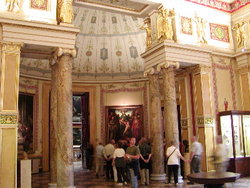Hermitage Museum
|
|
The Hermitage Museum (Эрмитаж) in St. Petersburg, Russia is one of the largest, oldest and most important art galleries in the world. The vast Hermitage collections are displayed in six buildings, the main one being the Winter Palace which used to be the official residence of the Russian Tsars.
Strong points of the Hermitage collection of Western art include Michelangelo, Leonardo, Rubens, Van Dyck, Rembrandt, Poussin, Claude Lorraine, Watteau, Tiepolo, Canaletto, Canova, Rodin, Monet, Pissarro, Renoir, Cezanne, Van Gogh, Gauguin, Picasso, and Matisse. But there is actually much more to see - the Russian imperial regalia, a superb assortment of Faberge jewellery, and a breathtaking collection of ancient gold.
| Contents |
Origin
Catherine the Great started things off in 1764, when she purchased more than 250 paintings in Europe. Russian ambassadors in foreign capitals were commissioned to acquire the best collections offered for sale: Brühl's collection in Saxony, Crozat's in France and the Walpole gallery in England. Catherine called her art gallery my hermitage, as very few people were allowed within to see its riches. In one of her letters she lamented that "only the mice and I can admire all this."
Expansion in the 19th century
New_hermitage.jpg
Gradually imperial collections were enriched by relics of Greek and Scythian culture, unearthed during excavations on ancient burial mounds in southern Russia. Thus started one of the world's richest collections of ancient gold, which now includes a substantial part of Troy's treasures unearthed by Heinrich Schliemann and seized from Berlin museums by the Red Army in 1945.
To house the ever-expanding collection of Greek, Roman, and Egyptian antiquities, Nicholas I commissioned the fashionable German architect Leo von Klenze to design a building for the public museum. Probably the first purpose-built art gallery in Eastern Europe, the New Hermitage was opened to the public in 1852.
As the Russian tsars continued to amass their art holdings, several works of Leonardo da Vinci, Jan van Eyck, and Raphael were bought in Italy. The Hermitage collection of Rembrandts was considered the largest in the world; its quality is still unsurpassed.
Vicissitudes in the 20th century
The imperial Hermitage was proclaimed public property during the Revolution. The range of its exhibits was further expanded when private art collections were being nationalized. Particularly remarkable was the influx of modern art from collections of Sergei Shchukin and Ivan Morozov. New acquisitions included most of Gauguin's later ouevre, a lot of Cubistic works by Picasso, and such icons of modern art as Matisse's La danse and Vincent van Gogh's Night Cafe.
New_hermitage_interior.jpg
The Soviet government did not pay much attention to maintenance of "bourgeois and decadent" art. What is worse, Stalin ordered some of the most precious Hermitage works to be sold abroad. These included unqualified masterpieces like Raphael's Madonna Alba, Titian's Venus with a Mirror and Jan van Eyck's Annunication. Acquired by Andrew W. Mellon, most of these works formed a nucleus of the National Gallery of Art in Washington, D.C.. There were other losses, though somewhat less irreplaceable: thousands of works were moved from the Hermitage collection to the Pushkin Museum in Moscow and other museums across the USSR.
The tragic period in Hermitage's history came to an end in 1945. At that time the government attempted to compensate recent losses by transferring to the museum some of the art looted by the Red Army in Germany during World War II. By far the most precious part of that booty were Impressionist and Post-Impressionist paintings taken from private collections of German business elite. These paintings were considered lost until 1995 when the museum unveiled them to the public. The Russian government maintains that these works provide just a small compensation for irreparable losses inflicted on Russian cultural heritage by the German invasion, including the almost complete destruction of Peterhof and Tsarskoe Selo. Moreover, the State Duma passed a law forbidding return of disputed works to their owners in case they were guilty of financing the Nazi regime.
In the 21st century
In recent years, Hermitage expanded to the nearby building of the General Staff and launched several ambitious projects abroad, including the Guggenheim Hermitage Museum in Las Vegas, the Hermitage Rooms in London's Somerset House, and the Hermitage Amsterdam in the former Amstelhof, Amsterdam.
The Hermitage was featured in the film Russian Ark, an incredible single shot walk through with period reenactments spanning three hundred years of court meetings, balls, and family life in the Winter Palace.
HermitageAcrossNeva.jpg
External links
- Official web site (http://www.hermitage.ru)
- Hermitage Amsterdam (http://www.hermitage.nl)
- Guggenheim Hermitage Museum (http://www.guggenheimlasvegas.org)
- Hermitage rooms in London (http://www.hermitagerooms.com)de:Eremitage (St. Petersburg)
eo:Ermitejo fr:Palais d'hiver it:Museo dell'Ermitage di San Pietroburgo nl:Hermitage ja:エルミタージュ美術館 pl:Ermitaż ru:Государственный Эрмитаж fi:Eremitaai sv:Eremitaget


